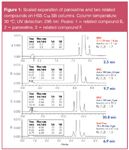HSS HPLC Columns: An Additional Option for Transferring Methods between HPLC and UPLC Technology
The Application Notebook
As UPLC users convert or replace their existing HPLC systems with UPLC systems there is a transition period where a method must be run on both platforms. Thus, having the same particle substrate and bonded phases available in HPLC and UPLC particle sizes can significantly ease the burden of method development and transfer from one platform to another. In addition to the ethylene bridged hybrid (BEH) particle, three new high strength silica (HSS) stationary phases for HPLC applications are introduced. Scalability between both column diameter and particle size is demonstrated on both UPLC and HPLC instrumentation.
Zhe Yin, Kenneth J. Fountain, Doug McCabe and Diane M. Diehl, Waters Corporation, Milford, Massachusetts, USA.
Introduction
As UPLC users convert or replace their existing HPLC systems with UPLC systems there is a transition period where a method must be run on both platforms. Thus, having the same particle substrate and bonded phases available in HPLC and UPLC particle sizes can significantly ease the burden of method development and transfer from one platform to another. In addition to the ethylene bridged hybrid (BEH) particle, three new high strength silica (HSS) stationary phases for HPLC applications are introduced. Scalability between both column diameter and particle size is demonstrated on both UPLC and HPLC instrumentation.
Experimental
Systems: UPLC — ACQUITY UPLC and PDA HPLC — Alliance 2695 and 2998 PDA
Columns (Figure 1): ACQUITY UPLC HSS C18 SB
Columns (Figure 2): ACQUITY UPLC HSS C18, 3.5 µm,
Mobile phase A: 0.1% TFA in H2O
Mobile phase B: 0.1% TFA in MeCN
Results and Discussion
Figure 1 shows the scalability between UPLC and HPLC columns for the separation of paroxetine-related compounds on HSS C18 SB. Gradient, flow-rate and injection volume were properly scaled between different particle sizes and column dimensions. The system volume was properly compensated for when transferring method between UPLC and HPLC instrumentations. Chromatographic resolution and selectivity were maintained across all separation platforms.

Figure 1
Figure 2 demonstrates the scalability between columns with different internal diameters for the separation of a forced degradation sample of glimepiride.

Figure 2
Conclusions
A successful method transfer requires careful consideration of key parameters including system volume, column dimension and particle size, injection volume and gradient profile. Methods can be easily transferred between different systems (UPLC → HPLC → prep), particle sizes and column diameters on the new HSS columns.
For the complete application note, visit www.waters.com/32122
© 2009 Waters Corporation. Waters, The Science of What's Possible, UPLC and ACQUITY UPLC are trademarks of Waters Corporation.

Waters Corporation
34 Maple Street, Milford, Massachusetts 01757, USA
tel. +1 508 478 2000 fax +1 508 478 1990
Website: www.waters.com

Free Poster: NDSRI Risk Assessment and Trace-Level Analysis of N-Nitrosamines
April 25th 2025With increasing concern over genotoxic nitrosamine contaminants, regulatory bodies like the FDA and EMA have introduced strict guidelines following several high-profile drug recalls. This poster showcases a case study where LGC and Waters developed a UPLC/MS/MS method for quantifying trace levels of N-nitroso-sertraline in sertraline using Waters mass spectrometry and LGC reference standards.
New TRC Facility Accelerates Innovation and Delivery
April 25th 2025We’ve expanded our capabilities with a state-of-the-art, 200,000 sq ft TRC facility in Toronto, completed in 2024 and staffed by over 100 PhD- and MSc-level scientists. This investment enables the development of more innovative compounds, a broader catalogue and custom offering, and streamlined operations for faster delivery. • Our extensive range of over 100,000 high-quality research chemicals—including APIs, metabolites, and impurities in both native and stable isotope-labelled forms—provides essential tools for uncovering molecular disease mechanisms and exploring new opportunities for therapeutic intervention.
New Guide: Characterising Impurity Standards – What Defines “Good Enough?”
April 25th 2025Impurity reference standards (IRSs) are essential for accurately identifying and quantifying impurities in pharmaceutical development and manufacturing. Yet, with limited regulatory guidance on how much characterisation is truly required for different applications, selecting the right standard can be challenging. To help, LGC has developed a new interactive multimedia guide, packed with expert insights to support your decision-making and give you greater confidence when choosing the right IRS for your specific needs.
Using the Carcinogenic Potency Categorisation Approach (CPCA) to Classify N-nitrosamine Impurities
April 25th 2025Learn how to manage nitrosamine impurities in pharmaceuticals with our free infographic. Discover how the CPCA approach establishes acceptable intake limits and guides the selection of NDSRI reference samples. Stay compliant and ensure safety with our ISO-accredited standards.

.png&w=3840&q=75)

.png&w=3840&q=75)



.png&w=3840&q=75)



.png&w=3840&q=75)













